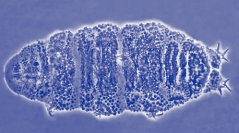

 Zoosystema
41 (6) - Pages 71-89
Zoosystema
41 (6) - Pages 71-89Tardigrades constituting the order Parachela are characterised by a generally uniform, worm-like external morphology. Taxa with larger, well-pronounced dorsal cuticular protuberances, tubercles and spines are found in seven genera representing various evolutionary lineages within Hypsibioidea and Isohypsibioidea: Calohypsibius Thulin, 1928 (Calohypsibiidae), Fractonotus Pilato, 1998 (Microhypsibiidae), Ramazzottius Binda & Pilato, 1986 (Ramazzottiidae), Hypsibius Ehrenberg, 1848 and Pilatobius Bertolani, Guidetti, Marchioro, Altiero, Rebecchi & Cesari, 2014 (Hypsibiidae), and Doryphoribius Pilato, 1969 and Isohypsibius Thulin, 1928 (Isohypsibiidae). Here, we present the first integrative analysis of a rare eutardigrade species, Calohypsibius verrucosus (Richters, 1900), classified until now within the superfamily Hypsibioidea. The species, having a strongly sculptured cuticle, only superficially resembles Calohypsibius but the modified Isohypsibius-type claws and the morphology of the buccal apparatus place it in a different genus, Fractonotus. The genus is currently classified within the family Microhypsibiidae and superfamily Hypsibioidea, but the first molecular data for Fractonotus show that it should be transferred to the family Isohypsibiidae within the superfamily Isohypsibioidea. We also show ontogenetic variability in cuticle morphology, which, together with the high intraspecific variability of F. verrucosus n. comb., allowed us to designate Calohypsibius placophorus (da Cunha, 1943) as a junior synonym of the former species. Furthermore, an analysis of type specimens of Isohypsibius gilvus Biserov, 1986 demonstrated its affinity to the revised Fractonotus. Finally, the diagnoses for Microhypsibiidae, Calohypsibiidae, Calohypsibius and Fractonotus are amended and claw morphology is suggested as a key trait for disentangling phyletic affinities within Isohypsibiidae sensu lato.
Bucco-pharyngeal apparatus, claws, cuticle, morphology, phylogeny, new synonyms, new combinations.